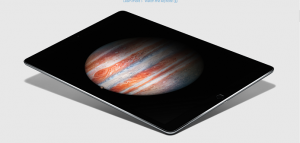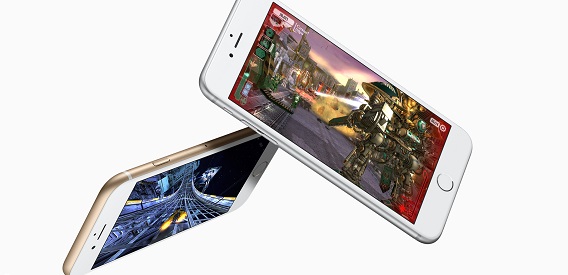ISLAMABAD ( MEDIA REPORT )
Apple unveiled the latest version of its iPhone line at a broad-ranging event that also saw the debut of a large-screen iPad.
iPhone 6s and iPhone 6s Plus
While iPhone 6s and iPhone 6s Plus look very much like the existing versions, Tim Cook, Apple’s CEO, claimed that “we’ve changed everything about these new iPhones”.
The headline new feature is the addition of pressure sensing to the touch input, an anticipated feature, although the name – 3D Touch – differs from the Force Touch used in Apple Watch (it was inadvertently referred to as Force Touch in the live demonstration).
The new technology detects the intensity of a press, for example enabling users to peek into email content, or access app features from the icons on the home screen through pressure-sensing menus.
While Huawei showed-off a similar technology in its new Mate S at IFA 2015 in Berlin last week, the Chinese vendor is restricting the technology to a single high-end version, availability of which has not been revealed. Apple, contrastingly, has deeply integrated it with iOS 9.
“The 3D Touch improvements will give existing iPhone owners an important reason to upgrade,” wrote analyst firm IHS in a research note. “As their existing apps are updated with 3D Touch, third party app developers will market the improvements to their apps which will help Apple communicate the benefits of the iPhone 6S, without Apple having to spend anything on advertising or marketing.”
The other big update came in the iPhone’s camera capabilities. As expected, the main (rear) camera has been upgraded to 12MP from 8MP in the previous version and also gained 4K video capture capabilities.
Also new is a Live Photos feature, which captures images either side of a shot to create short bursts of motion. Phil Schiller, SVP of worldwide marketing at Apple, pointed out that these are not videos, but a series of still images, and the feature is on by default to reduce user interaction.
The front-facing camera has been upgraded to 5MP and, rather than adding a front-facing flash alongside, the screen can now be used to add light to a scene.
The iPhone 6s and iPhone 6s Plus have also seen a bump under the hood. The new A9 chip is said to be 70 per cent faster at computing tasks than A8, which Schiller described as a “big jump in performance”.
Other updates include an integrated motion co-processor, “allowing more features to run all the time at lower power”, and 2nd generation Touch ID sensor which is twice as fast. LTE-Advanced with support for up to 23 bands – the most in any smartphone – and improved Wi-Fi provide a connectivity boost.
Colour options are silver, gold, space grey, and a new rose gold.
Pricing for the iPhone 6s is $199 (16GB), $299 (64GB) and $399 (128GB) when bought with a two-year service contract – the company did not give guidelines for unsubsidised. iPhone 6s Plus costs $100 more at each level.
In line with its usual practice, Apple has reshuffled its existing products: iPhone 5s has become the new entry-level device (available free with two-year contract), with iPhone 6 starting at $99 and iPhone 6 Plus from $199.
The devices will be available for pre-order from Saturday, with device deliveries in 12 initial markets starting 25 September (including China and US). By the end of the year, iPhone 6s and iPhone 6s Plus will be available in 130 countries.
iPad Pro, iPad Mini 4

The device has a 12.9-inch screen (measured across the diagonal), with a width that is equivalent to the iPad Air’s height. Its 2732×2048 (5.6 million) pixel screen has “even more pixels than a 15-inch Macbook Pro with Retina display,” Schiller said.
Of course, there is more to the device than the screen, and the internals are suitably beefy. It is powered by an A9X processor, Apple’s 3rd generation 64-bit chip, which is 1.8 times faster than the previous A8X, and offers “desktop class performance”.
Schiller said that the device will “enable new classes of application for iPad”, citing examples such as computer aided design and video editing. And, showcasing its capabilities, there were demonstrations from design software specialist Adobe and Microsoft, with the Apple executive commenting of the latter: “these guys know productivity”.
Indeed, with its large screen, stylus input, keyboard accessory and business focus, iPad Pro has become a close rival to Microsoft’s own Surface hardware.
Other features include 10-hour battery life, 8MP iSight camera and fingerprint scanner. iPad Pro is Apple’s first to feature a four-speaker audio system, and a keyboard cover peripheral will also be available.
The device will hit the shelves from November 2015 in silver, gold and space grey, with prices starting from $799 for the 32GB version, rising to $949 for 128GB, and $1079 for 128GB with LTE connectivity.
Apple Pencil will cost $99, and the Smart Keyboard is a $169 accessory.
Early analyst comment suggested that the iPad Pro could become an attractive enterprise platform but its high price will be a barrier.
In comparison to the attention given to iPad Pro, iPad Mini 4 was almost an afterthought. Schiller described the device as being an iPad Air 2 in a smaller housing.
iPad Mini 2 is now the entry-level tablet, priced at $269, with iPad Mini 4 at $399. iPad Air ($399) and iPad Air 2 ($499) remain unchanged, before stepping-up to the $799 iPad Pro.
Courtesy…. Mobile world live

